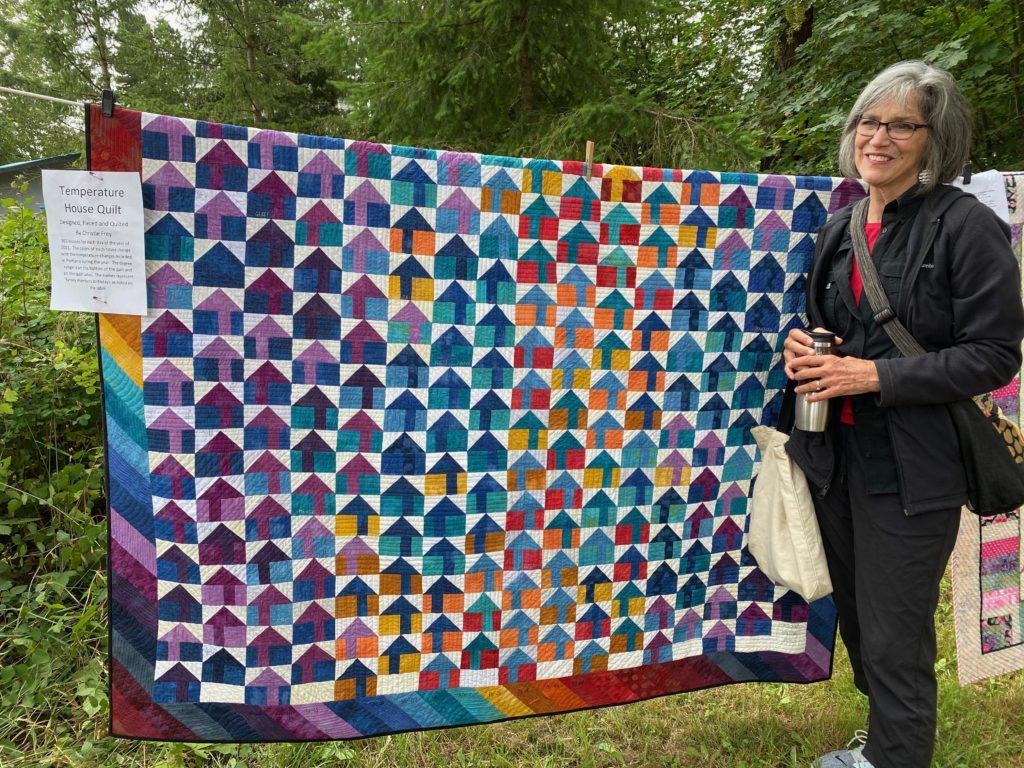A few years ago, I saw a quilt hanging in the Metropolitan Patchwork Society Outdoor Quilt Show – that really captured my attention. The maker, Christie Frey explained to me that it was a Temperature Quilt. Christie was kind enough to let me share a picture of her quilt. Christie and her beautiful quilt are pictured below.

What’s a Temperature Quilt?
When I first saw Christie’s quilt – I had never heard of a Temperature Quilt. I’m not sure I had ever seen one before – or if I had I didn’t realize what I was looking at. I was wowed – and went on a search to learn more about Temperature Quilts. I’ve learned – a lot!
A temperature quilt is a record of the daily (or weekly) high and low temperatures over the course of a period of time – typically a year. One block would represent a day (or a week). In the inspiration example that Christie made – each of her daily blocks uses three fabrics. One temperature is represented by the body of the house, and another is represented by the roof and door. Each block uses white as the background fabric.
Recording Temperatures
I thought this part would involve watching the weather report every day and writing down the high and low temperatures for the day. Nope. There’s a website for that (several actually) – Weather Underground is the site I used. I looked up the temperatures and recorded them in a small calendar – that worked perfectly for me.
Most people record the temperatures for the current year. That’s not your only option. How about making a temperature quilt for the year you were born? It could be any year – or any reason you want to memorialize in a quilt.
Creating the Temperature Scale
The range of temperatures is divided into groups, and each group is assigned a color. Depending on where you live and the average temperatures in your area – your lowest or highest temperature ranges could be much higher or lower than here in Oregon. You may want to create divisions of 5 degrees if you want to use a lot of colors or 10 degrees if you want to use fewer colors.
Here’s an example: Divisions of 5 or 10 degrees (if you click on the image below – you can print it out).

Choosing Blocks for the Quilt
Christie chose to make a simple but charming house for her quilt. I’ve seen blocks using only two fabrics – like Half Square Triangles, Square in a Square or a Circle appliqued on a Square. Keep in mind that you will be making hundreds of blocks if you are making a block to represent every single day in a year. Pick a block you like that looks great set into rows – and that you can make hundreds of without driving yourself crazy.
I played around with lots of different blocks in both square and rectangular formats. I wanted to use a block that was quick to cut and sew but that didn’t look too simple. Right up until now – I’ve been going back and forth between two different blocks. Each uses two temperature fabrics and a background fabric. You’ll need to wait a bit to see which one I chose (that’s a tease ; )
Size Matters
The block size you choose will determine how big the project will be. Assuming you will be making one block for each day of the year and you want to make a quilt of a particular size – your blocks will need to be sized correctly. Here’s a guideline:
- Crib: Make 1-1/2 inch blocks
- Throw: Make 2 or 2-1/2 inch blocks
- Twin: Make 3 or 3-1/2 inch blocks
- Queen: Make 5 or 5-1/2 inch blocks
- King: Make 6 – 6-1/2 inch blocks
Layout
You may have figured out that 365 (or 366) days / blocks do not layout out to make a perfect number of blocks and rows. You will have some space that need to be incorporated into the top in order for the top to layout correctly. In future posts – I’ll show some examples for dealing with the layout issues.
Choosing Fabrics
The fabrics you choose don’t need to be organized into a rainbow, although many makers choose to do that. Make sure there is some contrast between the temperature colors and whatever you choose to use as a background (if you have one).
I chose my colors for each temperature range right away. No problem at all. At that time, I decided to use a black background so all those batiks I’m using would really pop off the background. Then the project sat and waited while other life events happened. Now that I’m ready to start making blocks – I changed my mind about the black background.
One of the most interesting things about a temperature quilt is the way the fabrics show the rising and falling of the temperatures over the course of the year. Go back and look at the quilt Christie made and you’ll see what I mean.
What Comes Next?
I’ll be sharing updates about my progress making this quilt (which is being made to celebrate our 20th wedding anniversary). I don’t know how long it will take me – I’m making a block for every day of 2024, and it will end up being a queen-size quilt.
Next time, I’ll share my fabric selections and the background I chose. I’ll also share a sample block or two.
More Info about Making a Temperature Quilt
Temperature Quilts – Choosing Blocks
Choosing Fabrics to Make a Temperature Quilt.
